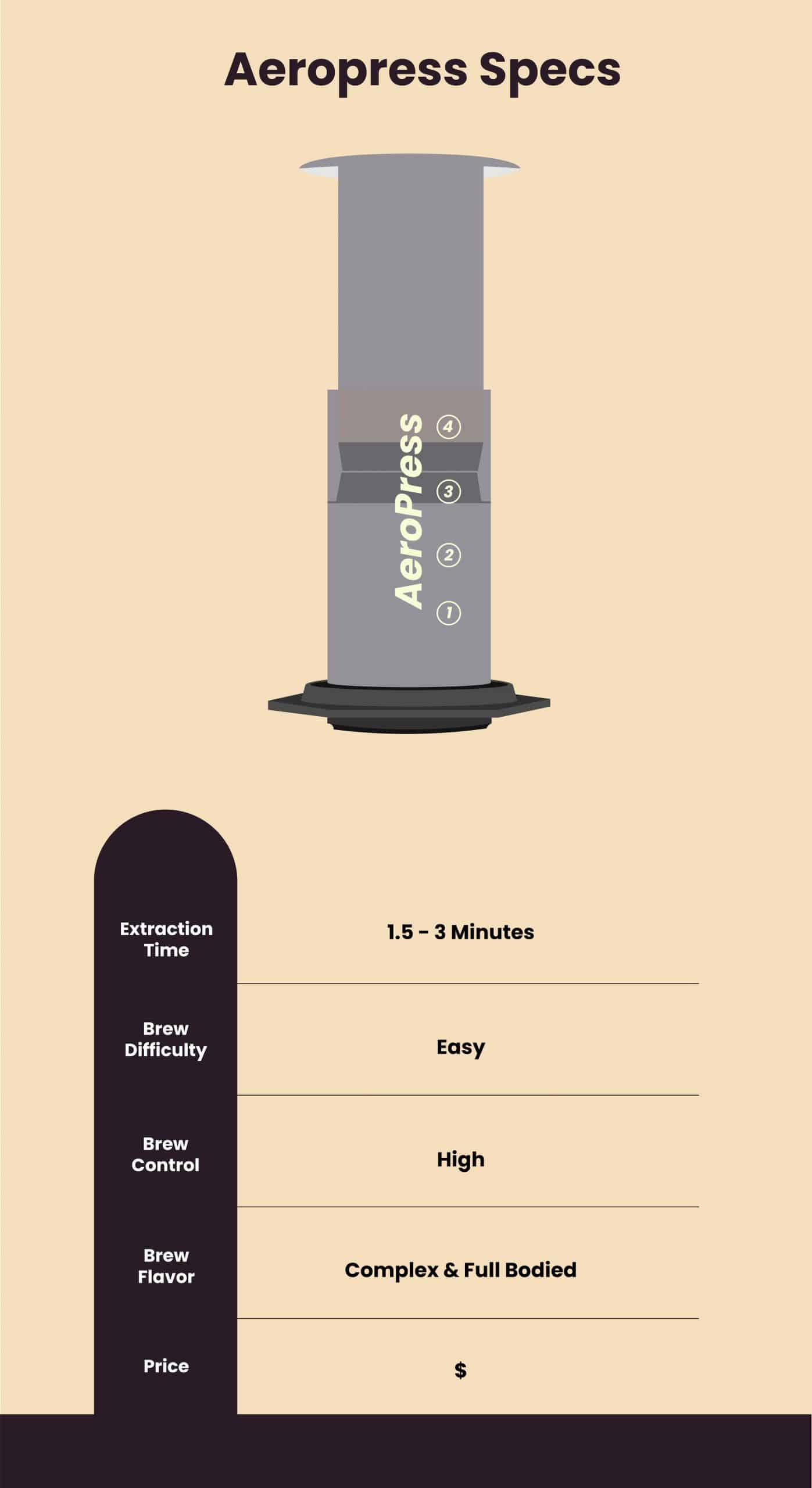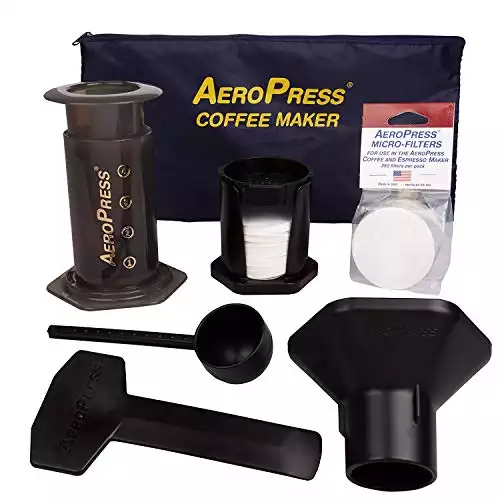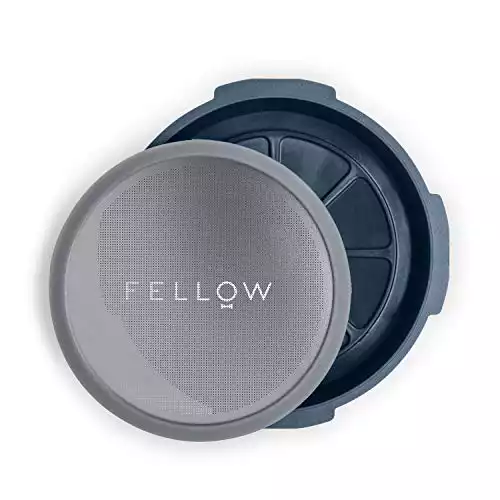Aeropress Review 2024 – The Most Versatile Brewer?
The Aeropress coffee maker is fast, affordable, and virtually indestructible compared to other brewers. Let’s take a closer look to see exactly why there’s way more than meets the eye with this brewing method.
Welcome to my Aeropress review!
What’s an Aeropress?
An Aeropress is a device that can produce a set of broad coffee based drinks. It can make anything from brewed coffees, espresso, and cold brew!
It was invented by Alan Adler, president of Aerobie, a sporting goods company. Initially, it was called the Aerobie Aeropress.
While sales didn’t take off immediately, the third wave of coffee has helped propel the Aeropress’s popularity. The move from finished product to brewing methods has proven that the coffee science behind Adler’s design was sound.
PROS (+)
- Makes good brewed coffee and espresso, as well as cold brew.
- Known for ease of use, and fast brew time
- One of the most durable coffee makers around, even more so than the french press
CONS (-)
- Only produces one or two cups of coffee at a time
- Not Ideal with lighter roasts (In my opinion)
The Aeropress was born in 2004 from dissatisfaction with existing brewing methods at the time.
Alan Adler aimed to invent a coffee maker that reduced bitterness in his cup. He studied existing models to see if he could develop a new brew method that brews a good cup of joe more consistently. From this simple why, he invented what we know today as the Aeropress.

It has become such an essential pillar of specialty coffee that there are annual Aeropress competitions held globally. In these coffee events, competing brewers showcase recipes with intricate detail.
Where they use various methods and workflows, a testament to how fun it is as a style. Coffee becomes such a fun beverage to tinker with after you get past your individual learning curve. So keep pushing to find what the perfect cup is for you and practice making it!
Did you know that the Aeropress combines coffee principles from the espresso machine, french press, and pour over coffee makers? Even AeroPress espresso is a thing!
We will get into more details later on. First, let’s jump to what type of brewer will want to make coffee with the Aeropress.
Who’s The Aeropress For?
The Aeropress is easy to use for people who enjoy the process of making good coffee. In small batches. It’s simple to use, but you will have to keep track of quite a few variables as you brew coffee with it. But if you like making one or two cups per batch of coffee, then this an option that could fit your coffee habit.
If you have a thermometer to measure the water temperature before you brew and a scale to measure coffee grounds, this could be a coffee brew method which could work exceptionally well for you.
You wet grounds like you do with pour overs, Immersing the grounds and push down like you do with a french press, but within a sealed chamber.
Extraction speeds up with the added pressure (just like with espresso), but in return, you can enjoy brewed coffee and espresso as you like.
Since it’s made of good quality plastic, it’s also great for travel. So if you’re the type of coffee person who appreciates a tasty cup of coffee on top of a mountain or at the beach, this is a brew method worth exploring.
Some kits come with a bag (like the one below), but you can also purchase a coffee kit container to go along with you on your trips. There is no specific time or place when you brew the best cup for you!
Lastly, whether you’re a new or experienced coffee maker, the Aeropress is for those who want a better understanding of the coffee brewing process.
Every time you use your Aeropress, you’ll discover what you like and dislike more and more. You’ll see the effect of grind size, water temperature, filter type, steeping time with your process.
You’ll also notice how the origin and roast level of your ground coffee will affect your brew.
I personally like to cycle through Volcanica coffee beans when I’m trying to learn new brew methods. They’re consistent, tasty, and some of the best for my personal taste.
The Design
At first glance, before any coffee knowledge whatsoever, I remember wondering if the Aeropress was a futuristic french press. This was only partly true.
The Aeropress makes use of immersion and pressure for extraction. Immersion comes from the french press side, and the pressure from the sealed chamber comes from the espresso maker side. Finally, gently pouring the hot water through the ground coffee is taken from pour overs.
To make a great brew, the pouring technique is essential. You want to keep an ideal contact time for a good extraction. Pouring too slow will ruin your ratio while leaving your ground coffee exposed to heat longer than you want to. Pour too fast, and you will extend brewing time, causing a bitter, over-extracted brew.
The flexible design has ensured a variety of third party add ons are available. Including the below from Fellow, a great add on if you enjoy espresso:
There are many different ways to use the Aeropress, as it was designed to accommodate different styles to make delicious coffee. But it’s important to note that each step of making brews with the Aeropress has significant effects on your brew’s taste. Define what “delicious coffee” is for you to understand how to make it consistently.
Two design aspects I love most about the Aeropress are the sealed chamber and the filter. These are the two variables you can use at the start to understand how your Aeropress works and how changing specific steps affect your brewed coffee.
Build Quality
The original Aeropress coffee makers are made of BPA-free plastic. Even when you brew with hot water, they claim that studies have shown zero leakage of harmful chemicals into your cup.
Other parts of this amazing coffee press aside from the 2 cylinders are the rubber plunger, the filter cap, a funnel, a stirrer, and a paper filter holder.
These parts come together (in 30 different variations depending on barista workflows) to form an Aeropress coffee maker that is easy to clean and easy to brew with. Whether you brew with paper filters or metal ones, almost anyone can make a great cup of coffee with the Aeropress when given proper instructions.
While the Aeropress is one of the best pieces of coffee equipment in terms of durability, there is one part that you need to care for: the rubber plunger. This plunger uses trapped air in the sealed chamber to push hot water through coffee grounds. It’s the unique selling proposition of brewing with the Aeropress.
One tip I can give to preserve your Aeropress plunger is not subjecting it to an extreme, rapidly set of changing temperatures.
Other than the rubber part of the plunger and its issue with rapid temperatures, the entire Aeropress could possibly be the only piece of coffee equipment that you can literally store anywhere without worrying about breakage. It’s light, durable, and makes great coffee.
Easy To Use
As a piece of equipment, the Aerobie Aeropress is best suited for those who enjoy brewing coffee. It has a quick brew time and is known for its ease of use.
It’s even been advertised as self-cleaning because of the plunger that basically allows you to push out everything from the last brew you made with your Aeropress. Whether you brew with metal or paper filters, you’re a quick rinse or a quick toss away from resetting.
There are two general ways to brew via this coffee press. The classic (or original) method and the inverted method. Let’s compare each one. When you can, try both ways and see which one is good and natural for your brewing pleasure.
Check out our Aeropress brewing guide or the recipes below to learn more:
The Classic (or Original) Method
- Heat your (mineral H2O) (prepare a 1:12-15 ratio of grounds to H2O, and add an extra 100ml for rinsing your paper filter.
- Grind your beans at a medium-fine setting.
- Wet the filter after assembling your Aeropress.
- Add the ground beans, and even out the coffee bed at the bottom
- Add in water. It’s good to pour in circles for some additional, light agitation that helps with extracting flavor.
- Start the immersion. Your total brew time should be within 2.5 minutes on average—immerse grounds anywhere from 1-2 minutes.
- (Optional) stir with a paddle before pushing.
- Press down with a steady, controlled pace, right until you head a hissing sound. This means you’ve pushed out the H2O, and only air is hitting your coffee grinds.
- Enjoy!
The Inverted Method
- Assemble your Aeropress upside down.
- Heat your (mineral H2O) (prepare a 1:12-15 ratio of grounds to H2O, and add an extra 100ml for rinsing your paper filter.
- Grind your beans at a medium-fine setting.
- Add the ground beans, and even out the coffee bed at the bottom.
- Add in water. It’s good to pour in circles for some additional light agitation that helps with extracting flavor.
- Start the immersion. Your total brewing time should be within 2.5 minutes on average. Immerse grounds anywhere from 1-2 minutes.
- (Optional) stir with a paddle before pushing.
- Carefully flip over the Aeropress coffee maker right into your mug or server.
- Press down with a steady, controlled pace, right until you head a hissing sound. This means you’ve pushed out the H2O, and only air is hitting your coffee grinds.
- Enjoy!
If we do a quick review of both methods, there is just that one extra step with the inverted way of making brews with the Aeropress. The main difference is that inversion prolongs the total contact period between water and grounds, while the classic method allows a continuous drip through the paper or metal filter.
When you experiment at the start with an Aeropress, it lowers wastage when you brew a single cup at a time! Keep making good coffee until you create great coffee with your Aeropress!
The Flavor
The Aeropress is known to make tasty coffee. You can do a pour over style, with clear flavors bursting through a light body. Lightly roasted beans and using a paper filter will help you achieve this flavor profile.
For a full-bodied cup of coffee, one upgrade they have is the metal filter. When you use this in place of the paper filter, more oils and fines seep into your cup of coffee. Things may earn you a step closer to an espresso-like brew for a fraction of the cost of an espresso machine. In fact, the cost of an Aeropress is closer to a french press!
Lastly, if you want your Aeropress to produce a coffee that is in between an espresso and a french press, try tightening the ratio of your water, extending your extraction, all while using medium-dark roasted beans. Remember to install the metal filter instead of the paper one.
If I were to do an Aeropress review on flavors, I’d personally pick the classic method using paper filters. I try to choose a coffee maker that gives me clear flavor notes, a light body, and quick brew times.
Frequently Asked Questions
Is Aeropress really that good?
If we were to do a comprehensive review, it would yield a one-word ending: yes. Compared to other methods, you get a lot more movement with each step of your workflow, thus deepening your understanding of coffee. However, with the equipment itself, your variables are controlled enough for consistency to come from technique and experience.
Is Aeropress better than French Press?
It really depends on you. I have moods for different hand brews, espresso, dessert coffees, etc. You can compare specific products and models, but they are both versatile enough to go toe to toe with each other as brewers.
Which is the best Aeropress?
The best Aeropress for me is the original, classic Aeropress. It’s already one of the best and simplest to make brews with overall as a coffee maker.
What is the best way to use the Aeropress?
As mentioned above, for my personal preference, I do the Aeropress with a classic workflow. This is because I enjoy light-bodied, clear flavored cups of joe if I’m not slurping on an espresso.



